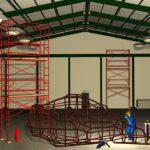
Over 50% of American-made products require some form of welding. From commercial projects to industrial construction, welding is one of the most sought-after skills in the workforce.
You might be a hobby welder or an up-and-coming pro. You might be a homeowner who wants to understand how welding affects you. In any case, it’s beneficial to understand the different welding types and their applications.
If you are looking to brush up on the most common types of welding, keep reading. This article will explain the most popular welding technologies, how they work, and which applications you should use each one for.
MIG Welding
MIG welding is one of the most popular methods of welding for its safety and ease of use.
Metal Inert Gas (MIG) welding uses non-reactive gas to control the arc that melts the pieces of metal to be fused together. This provides a stable arc that is easy to maneuver.
The MIG machine feeds a spool of wire through the nozzle. The wire completes the welding arc and melts to provide the join between your two metal surfaces.
Benefits of MIG Welding
Because MIG welding uses non-reactive gas, this type of welding doesn’t react badly to contaminants or debris on your welding surface. Even though you should still clean and degrease your surfaces for best results, MIG welding is safer to use outside of an industrial environment.
MIG welding requires little equipment and is easy to learn. Not only that, but it’s versatile enough to be used on many different types of metals.
MIG welding has many industrial uses. In the welding industry, it is also known as Gas Metal Arc Welding (GMAW).
However, because it’s safe, versatile, and doesn’t require a lot of equipment, MIG welding is popular for hobby welders and DIY-ers. If you are interested in hobby welding, MIG welding is the perfect place to start.
Arc Welding
Also known as stick welding, arc welding uses an electrical current to melt the metal that you want to join.
In arc welding, you will use a welding machine that emits a DC or AC power current. One cable from the machine hooks up to your welding torch, and the other hooks up to the metal that you are working on. When you touch the welding electrode to the metal, it completes the arc and lets the electrical current flow through the metal.
Arc welding creates extremely high heat — up to 6500°F — which causes the metals to react with the oxygen in the air. To minimize this, arc welding uses a protective shield of gas to keep the melted metal from contacting the air.
Arc welding is more difficult to learn than MIG. It’s also more old-fashioned and can be messier. This makes it less popular for home projects.
However, it’s one of the strongest types of welding. The high temperatures it creates are sufficient to weld thick iron and steel. That’s why arc welding remains a good choice for non-precision industrial work.
TIG Welding
Tungsten Inert Gas welding (also known as Gas Tungsten Arc welding) is very similar to MIG welding. However, instead of using a feed wire to create molten metal that holds the two pieces of metal together, TIG welding uses tungsten rods to conduct the arc.
TIG welding allows the welder to control the amount of heat and energy used. This makes it possible to weld many different surfaces and types of metals.
In addition, TIG welding creates a thin weld. It can be used to weld curves, tight corners, and other detailed surfaces that require precision.
Dangers of TIG Welding
Despite its benefits, TIG welding is not beginner-friendly. The tungsten rod has to be carefully controlled to ensure that it never touches the welding material, which requires practice and skill. Unlike MIG welding, tungsten welding requires a completely clean welding surface to create a safe and effective weld.
Finally, although TIG creates a clean-looking finished product, it’s a time-consuming mode of welding. Without training, it’s difficult to get TIG welding right, which could lead to a messy-looking result — or worse, a welding injury.
TIG isn’t a good choice for fieldwork or hobby welding. However, its versatility and precision make it a good choice for specialized industry work.
Aerospace engineers rely on it to construct spacecraft and airplanes. It’s also popular in the auto repair industry to fix car parts and in creating clean construction joints.
While TIG welding is widely acknowledged to create the best-looking welding join, it requires professional skill.
Plasma Arc Welding
Like TIG welding, plasma arc welding uses a tungsten electrode to create the arc between the work surface and the welding machine. However, plasma arc welding is even more precise than TIG.
Plasma arc welding uses hot ionized gas (usually argon gas) and a DC power source. This lets you weld at super-high temperatures with great precision. In fact, plasma arc welding can join metals as thin as 0.015 inches without destroying them.
This type of welding is highly specialized and difficult to learn. Plasma arc welding is most commonly seen in aerospace engineering, where it is used for extremely precise work.
Find the Right Welding Types for Your Project
Whether your project is industrial, residential, or commercial, you’ll need to understand which kinds of welding you will need. With this guide, you’ll be able to differentiate between the most common welding types and understand which ones are right for your project.
If you’re looking for comprehensive welding services in Decatur, GA, turn to Wilson Welding Service. We’ve been providing high-quality welding and fabrication services since 1954. Contact us today for a free consultation.



